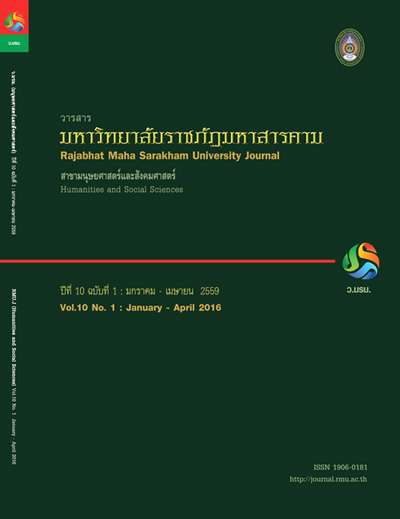การประเมินความแตกต่างประสบการณ์และผลการเรียนรู้ เรื่อง การแก้โจทย์ปัญหา คณิตศาสตร์ ของนักเรียนชั้นประถมศึกษาปีที่ 4 ที่เรียนด้วยการจัดการเรียนรู้ แบบกลุ่มร่วมมือเทคนิค KWDLกับการจัดการเรียนรู้ปกติ;A Assessing of the Difference of Learning Experience and
Main Article Content
บทคัดย่อ
การวิจัยครั้งนี้ มีวัตถุประสงค์เพื่อประเมินความแตกต่างประสบการณ์การเรียนรู้ที่เน้นผู้เรียนเป็นสำคัญและเปรียบเทียบ
ผลสัมฤทธิ์ทางการเรียนและทักษะกระบวนการทางคณิตศาสตร์ เรื่องการแก้โจทย์ปัญหาคณิตศาสตร์ ของนักเรียนชั้นประถมศึกษาที่
4 ระหว่างการจัดการเรียนรู้แบบกลุ่มร่วมมือ เทคนิค KWDL กับการจัดการเรียนรู้ปกติโดยกลุ่มตัวอย่างที่ใช้ในการวิจัยครั้งนี้ เป็น
นักเรียนโรงเรียนบ้านดู่น้อยและโรงเรียนลิ้นฟ้าวิทยาคาร สังกัดสำนักงานเขตพื้นที่การศึกษาประถมศึกษาร้อยเอ็ด เขต 1 จำนวน 30
คน เครื่องมือที่ใช้ในการรวบรวมข้อมูลได้แก่ 1)แผนการจัดการเรียนรู้กลุ่มสาระการเรียนรู้คณิตศาสตร์ที่เรียนด้วยการจัดการเรียนรู้
แบบกลุ่มร่วมมือเทคนิค KWDL เรื่องการแก้โจทย์ปัญหาคณิตศาสตร์ ชั้นประถมศึกษาปีที่ 4 จำนวน 14 แผน 2)แผนการจัดการเรียน
รู้กลุ่มสาระการเรียนรู้คณิตศาสตร์ที่เรียนด้วยการจัดการเรียนรู้ปกติ เรื่องการแก้โจทย์ปัญหาคณิตศาสตร์ ชั้นประถมศึกษาปีที่ 4 จำนวน
14 แผน 3) แบบประเมินประสบการณ์การเรียนรู้ที่เน้นผู้เรียนเป็นสำคัญ จำนวน 20 ข้อ ที่มีค่าอำนาจจำแนกตั้งแต่ 0.31 ถึง 0.66 และ
มีค่าความเชื่อมั่น เท่ากับ 0.62 4) แบบวัดผลสัมฤทธิ์ทางการเรียน จำนวน 30 ข้อซึ่งมีค่าอำนาจจำแนก (B) ตั้งแต่ 0.22 ถึง 0.85 มีค่า
ความเชื่อมั่นเท่ากับ 0.73 และ 5) แบบทดสอบทักษะกระบวนการทางคณิตศาสตร์ จำนวน 20 ข้อ ซึ่งมีค่าความยาก (P) ตั้งแต่ 0.68
ถึง 0.80 และมีค่าอำนาจจำแนก (r) ตั้งแต่ 0.21 ถึง 0.83 มีค่าความเชื่อมั่นเท่ากับ 0.69สถิติที่ใช้ในการวิเคราะห์ข้อมูลคือ ความถี่
ค่าเฉลี่ย ส่วนเบี่ยงเบนมาตรฐาน การทดสอบยูของแมน-วิทนีย์ และโฮเทลลิ่งทีกำลังสอง ผลการวิจัยพบว่า
1. นักเรียนที่ได้รับการจัดการเรียนรู้แบบกลุ่มร่วมมือ เทคนิค KWDL มีประสบการณ์การเรียนรู้ที่เน้นผู้เรียนเป็นสำคัญ สูงกว่า
นักเรียนที่ได้รับการจัดการเรียนรู้แบบปกติอย่างมีนัยสำคัญทางสถิติที่ระดับ .01
2. นักเรียนที่ได้รับการจัดการเรียนรู้แบบกลุ่มร่วมมือเทคนิค KWDL มีผลสัมฤทธิ์ทางการเรียน และทักษะกระบวนการทาง
คณิตศาสตร์ สูงกว่านักเรียนที่ได้รับการจัดการเรียนรู้แบบปกติ อย่างมีนัยสำคัญทางสถิติที่ระดับ .01
The objectives of this research were to assess the differences of child-centered learning experience in
entitle “Mathematics Problems Solving”,and to compare the achievement and mathematical process skills for
grade 4 students between cooperative learning-KWDL technique and traditional learning. The samples were
30 grade students in Ban Dunone School and Linpa Wittakakan, Office of Roi-et Primary Educational Service
Area 1. The research instruments consisted of : 1) 14 lesson plans in cooperative learning-KWDL technique;
2) 14 lesson plans in traditional learning; 3) a assessment form of child-centered learning experience that of
20 items with discrimination power 0.70-0.90 and reliability coefficient 0.96, 4) a achievement test about
“Mathematics Problems Solving” that consist of 30 items with discrimination power (B) 0.20-0.84 and reliability
coefficient 0.86; and 5) an mathematical process skills test consist of 20 items with difficultly indices (P) 0.37-
0.87, discrimination power (r) 0.25-0.78, and reliability coefficient 0.88. The statistics used to data analysis
include frequency, mean, standard deviation, Mann-Whitney U Test, and Hotelling’s T2
The findings were as follows:
1. Students that cooperative learning-KWDL technique had child-centeredlearning experience about
“Mathematics Problems Solving” higher than students who that traditional learning statistically significant at
.01 level.
2. Students that cooperative learning-KWDL technique had Achievement and analytical thinking about
“Mathematics Problems Solving” higher than students that traditional learning statistically significant at
.01 level.
Article Details
1. บทความที่ลงตีพิมพ์ทุกเรื่องได้รับการตรวจทางวิชาการโดยผู้ประเมินอิสระ ผู้ทรงคุณวุฒิ (Peer Review) สาขาที่เกี่ยวข้อง อย่างน้อย 3 ท่าน ในรูปแบบ Double blind review
2. ข้อคิดเห็นใด ๆ ของบทความที่ลงตีพิมพ์ในวารสารมหาวิทยาลัยราชภัฏมหาสารคาม นี้เป็นของผู้เขียน คณะผู้จัดทำวารสารไม่จำเป็นต้องเห็นด้วย
3. กองบรรณาธิการวารสารมหาวิทยาลัยราชภัฏมหาสารคาม ไม่สงวนสิทธิ์การคัดลอกแต่ให้อ้างอิงแสดงที่มา


